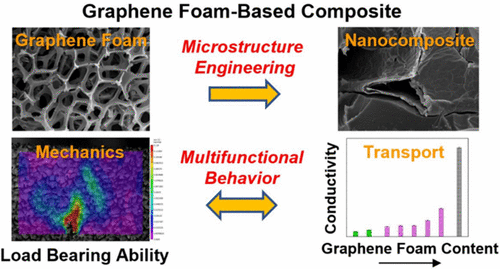当前位置:
X-MOL 学术
›
ACS Appl. Mater. Interfaces
›
论文详情
Our official English website, www.x-mol.net, welcomes your
feedback! (Note: you will need to create a separate account there.)
Three-Dimensional Graphene Foam Induces Multifunctionality in Epoxy Nanocomposites by Simultaneous Improvement in Mechanical, Thermal, and Electrical Properties
ACS Applied Materials & Interfaces ( IF 8.3 ) Pub Date : 2017-11-02 00:00:00 , DOI: 10.1021/acsami.7b14078 Leslie Embrey 1 , Pranjal Nautiyal 1 , Archana Loganathan 1 , Adeyinka Idowu 1 , Benjamin Boesl 1 , Arvind Agarwal 1
ACS Applied Materials & Interfaces ( IF 8.3 ) Pub Date : 2017-11-02 00:00:00 , DOI: 10.1021/acsami.7b14078 Leslie Embrey 1 , Pranjal Nautiyal 1 , Archana Loganathan 1 , Adeyinka Idowu 1 , Benjamin Boesl 1 , Arvind Agarwal 1
Affiliation

|
Three-dimensional (3D) macroporous graphene foam based multifunctional epoxy composites are developed in this study. Facile dip-coating and mold-casting techniques are employed to engineer microstructures with tailorable thermal, mechanical, and electrical properties. These processing techniques allow capillarity-induced equilibrium filling of graphene foam branches, creating epoxy/graphene interfaces with minimal separation. Addition of 2 wt % graphene foam enhances the glass transition temperature of epoxy from 106 to 162 °C, improving the thermal stability of the polymer composite. Graphene foam aids in load-bearing, increasing the ultimate tensile strength by 12% by merely 0.13 wt % graphene foam in an epoxy matrix. Digital image correlation (DIC) analysis revealed that the graphene foam cells restrict and confine the deformation of the polymer matrix, thereby enhancing the load-bearing capability of the composite. Addition of 0.6 wt % graphene foam also enhances the flexural strength of the pure epoxy by 10%. A 3D network of graphene branches is found to suppress and deflect the cracks, arresting mechanical failure. Dynamic mechanical analysis (DMA) of the composites demonstrated their vibration damping capability, as the loss tangent (tan δ) jumps from 0.1 for the pure epoxy to 0.24 for ∼2 wt % graphene foam–epoxy composite. Graphene foam branches also provide seamless pathways for electron transfer, which induces electrical conductivity exceeding 450 S/m in an otherwise insulator epoxy matrix. The epoxy–graphene foam composite exhibits a gauge factor as high as 4.1, which is twice the typical gauge factor for the most common metals. Simultaneous improvement in thermal, mechanical, and electrical properties of epoxy due to 3D graphene foam makes epoxy–graphene foam composite a promising lightweight and multifunctional material for aiding load-bearing, electrical transport, and motion sensing in aerospace, automotive, robotics, and smart device structures.
中文翻译:

三维石墨烯泡沫通过同时改善机械,热学和电学性质诱导环氧纳米复合材料的多功能性
本研究开发了基于三维(3D)大孔石墨烯泡沫的多功能环氧复合材料。简便的浸涂和压铸技术被用于设计具有可调整的热,机械和电性能的微结构。这些加工技术允许毛细管现象引起的石墨烯泡沫分支的平衡填充,从而以最小的分离度产生环氧/石墨烯界面。添加2 wt%的石墨烯泡沫可将环氧树脂的玻璃化转变温度从106℃提高到162℃,从而改善了聚合物复合材料的热稳定性。石墨烯泡沫有助于承载,在环氧树脂基体中仅0.13 wt%的石墨烯泡沫可将极限抗拉强度提高12%。数字图像相关(DIC)分析表明,石墨烯泡沫孔能限制和限制聚合物基体的变形,从而增强了复合材料的承载能力。添加0.6重量%的石墨烯泡沫也将纯环氧的弯曲强度提高了10%。发现石墨烯支链的3D网络可以抑制和偏转裂纹,从而阻止机械故障。复合材料的动态力学分析(DMA)证明了它们的减振性能,损耗角正切(tanδ)从纯环氧的0.1跃升至2 wt%的石墨烯泡沫-环氧复合材料的0.24。石墨烯泡沫分支还为电子转移提供了无缝的途径,这会在其他绝缘体的环氧树脂基体中感应出超过450 S / m的电导率。环氧-石墨烯泡沫复合材料的规格系数高达4.1,是最常见金属的典型规格系数的两倍。3D石墨烯泡沫可同时改善环氧树脂的热,机械和电性能,使环氧-石墨烯泡沫复合材料成为一种有前途的轻质多功能材料,可用于航空航天,汽车,机器人和智能设备的承重,电运输和运动传感设备结构。
更新日期:2017-11-03
中文翻译:

三维石墨烯泡沫通过同时改善机械,热学和电学性质诱导环氧纳米复合材料的多功能性
本研究开发了基于三维(3D)大孔石墨烯泡沫的多功能环氧复合材料。简便的浸涂和压铸技术被用于设计具有可调整的热,机械和电性能的微结构。这些加工技术允许毛细管现象引起的石墨烯泡沫分支的平衡填充,从而以最小的分离度产生环氧/石墨烯界面。添加2 wt%的石墨烯泡沫可将环氧树脂的玻璃化转变温度从106℃提高到162℃,从而改善了聚合物复合材料的热稳定性。石墨烯泡沫有助于承载,在环氧树脂基体中仅0.13 wt%的石墨烯泡沫可将极限抗拉强度提高12%。数字图像相关(DIC)分析表明,石墨烯泡沫孔能限制和限制聚合物基体的变形,从而增强了复合材料的承载能力。添加0.6重量%的石墨烯泡沫也将纯环氧的弯曲强度提高了10%。发现石墨烯支链的3D网络可以抑制和偏转裂纹,从而阻止机械故障。复合材料的动态力学分析(DMA)证明了它们的减振性能,损耗角正切(tanδ)从纯环氧的0.1跃升至2 wt%的石墨烯泡沫-环氧复合材料的0.24。石墨烯泡沫分支还为电子转移提供了无缝的途径,这会在其他绝缘体的环氧树脂基体中感应出超过450 S / m的电导率。环氧-石墨烯泡沫复合材料的规格系数高达4.1,是最常见金属的典型规格系数的两倍。3D石墨烯泡沫可同时改善环氧树脂的热,机械和电性能,使环氧-石墨烯泡沫复合材料成为一种有前途的轻质多功能材料,可用于航空航天,汽车,机器人和智能设备的承重,电运输和运动传感设备结构。





















































 京公网安备 11010802027423号
京公网安备 11010802027423号